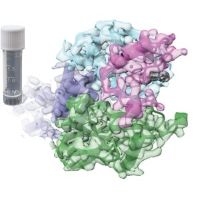Specification
| Description | Recombinant protein from the full-length sequence of homo sapiens protein kinase cAMP-activated catalytic subunit alpha (PRKACA), transcript variant 1 (NM_002730). |
| Organism | Homo sapiens (Human) |
| Expression Host | Human Cells |
| Tag Info | His or DYKDDDDK. Please contact us if you need further information or require specific designed tag. |
| Purity | Greater than 90% by SDS-PAGE gel |
| Uniprot ID | P17612 |
| Entry Name | KAPCA_HUMAN |
| Gene Names | PRKACA PKACA |
| Alternative Gene Names | PKACA |
| Alternative Protein Names | cAMP-dependent protein kinase catalytic subunit alpha (PKA C-alpha) (EC 2.7.11.11) |
| Application | Antigens, Western, ELISA and other in vitro binding or in vivo functional assays, and protein-protein interaction studies; For research & development use only! |
| Buffer | Purified protein formulated in a sterile solution of PBS buffer, pH7.2, without any preservatives |
| Endotoxin | Endotoxin level is < 0.1 ng/µg of protein (<1EU /µg) |
| Length | 351 |
| Molecular Weight(Da) | 40590 |
| Protein Sequence | (The sequence of expressed protein may have some variation from the sequence shown below. Please contact us for the exact sequence.) MGNAAAAKKGSEQESVKEFLAKAKEDFLKKWESPAQNTAHLDQFERIKTLGTGSFGRVMLVKHKETGNHYAMKILDKQKVVKLKQIEHTLNEKRILQAVNFPFLVKLEFSFKDNSNLYMVMEYVPGGEMFSHLRRIGRFSEPHARFYAAQIVLTFEYLHSLDLIYRDLKPENLLIDQQGYIQVTDFGFAKRVKGRTWTLCGTPEYLAPEIILSKGYNKAVDWWALGVLIYEMAAGYPPFFADQPIQIYEKIVSGKVRFPSHFSSDLKDLLRNLLQVDLTKRFGNLKNGVNDIKNHKWFATTDWIAIYQRKVEAPFIPKFKGPGDTSNFDDYEEEEIRVSINEKCGKEFSEF |
Background
| Function | FUNCTION: Phosphorylates a large number of substrates in the cytoplasm and the nucleus (PubMed:15642694, PubMed:15905176, PubMed:16387847, PubMed:17333334, PubMed:17565987, PubMed:17693412, PubMed:18836454, PubMed:19949837, PubMed:20356841, PubMed:21085490, PubMed:21514275, PubMed:21812984). Phosphorylates CDC25B, ABL1, NFKB1, CLDN3, PSMC5/RPT6, PJA2, RYR2, RORA, SOX9 and VASP (PubMed:15642694, PubMed:15905176, PubMed:16387847, PubMed:17333334, PubMed:17565987, PubMed:17693412, PubMed:18836454, PubMed:19949837, PubMed:20356841, PubMed:21085490, PubMed:21514275, PubMed:21812984). Regulates the abundance of compartmentalized pools of its regulatory subunits through phosphorylation of PJA2 which binds and ubiquitinates these subunits, leading to their subsequent proteolysis (PubMed:21423175). RORA is activated by phosphorylation (PubMed:21514275). Required for glucose-mediated adipogenic differentiation increase and osteogenic differentiation inhibition from osteoblasts (PubMed:19949837). Involved in chondrogenesis by mediating phosphorylation of SOX9 (By similarity). Involved in the regulation of platelets in response to thrombin and collagen; maintains circulating platelets in a resting state by phosphorylating proteins in numerous platelet inhibitory pathways when in complex with NF-kappa-B (NFKB1 and NFKB2) and I-kappa-B-alpha (NFKBIA), but thrombin and collagen disrupt these complexes and free active PRKACA stimulates platelets and leads to platelet aggregation by phosphorylating VASP (PubMed:15642694, PubMed:20356841). Prevents the antiproliferative and anti-invasive effects of alpha-difluoromethylornithine in breast cancer cells when activated (PubMed:17333334). RYR2 channel activity is potentiated by phosphorylation in presence of luminal Ca(2+), leading to reduced amplitude and increased frequency of store overload-induced Ca(2+) release (SOICR) characterized by an increased rate of Ca(2+) release and propagation velocity of spontaneous Ca(2+) waves, despite reduced wave amplitude and resting cytosolic Ca(2+) (PubMed:17693412). PSMC5/RPT6 activation by phosphorylation stimulates proteasome (PubMed:17565987). Negatively regulates tight junctions (TJs) in ovarian cancer cells via CLDN3 phosphorylation (PubMed:15905176). NFKB1 phosphorylation promotes NF-kappa-B p50-p50 DNA binding (PubMed:15642694). Involved in embryonic development by down-regulating the Hedgehog (Hh) signaling pathway that determines embryo pattern formation and morphogenesis. Prevents meiosis resumption in prophase-arrested oocytes via CDC25B inactivation by phosphorylation (By similarity). May also regulate rapid eye movement (REM) sleep in the pedunculopontine tegmental (PPT) (By similarity). Phosphorylates APOBEC3G and AICDA (PubMed:16387847, PubMed:18836454). Phosphorylates HSF1; this phosphorylation promotes HSF1 nuclear localization and transcriptional activity upon heat shock (PubMed:21085490). {ECO:0000250|UniProtKB:P05132, ECO:0000250|UniProtKB:P27791, ECO:0000269|PubMed:15642694, ECO:0000269|PubMed:15905176, ECO:0000269|PubMed:16387847, ECO:0000269|PubMed:17333334, ECO:0000269|PubMed:17565987, ECO:0000269|PubMed:17693412, ECO:0000269|PubMed:18836454, ECO:0000269|PubMed:19949837, ECO:0000269|PubMed:20356841, ECO:0000269|PubMed:21085490, ECO:0000269|PubMed:21423175, ECO:0000269|PubMed:21514275, ECO:0000269|PubMed:21812984}.; FUNCTION: [Isoform 2]: Phosphorylates and activates ABL1 in sperm flagellum to promote spermatozoa capacitation. {ECO:0000250|UniProtKB:P05132}. |
| Pathway | |
| Protein Families | Protein kinase superfamily, AGC Ser/Thr protein kinase family, cAMP subfamily |
| Tissue Specificity | Isoform 1 is ubiquitous. Isoform 2 is sperm-specific and is enriched in pachytene spermatocytes but is not detected in round spermatids. {ECO:0000269|PubMed:10906071, ECO:0000269|PubMed:21812984}. |
QC Data
| Note | Please contact us for QC Data |
| Product Image (Reference Only) |  |

